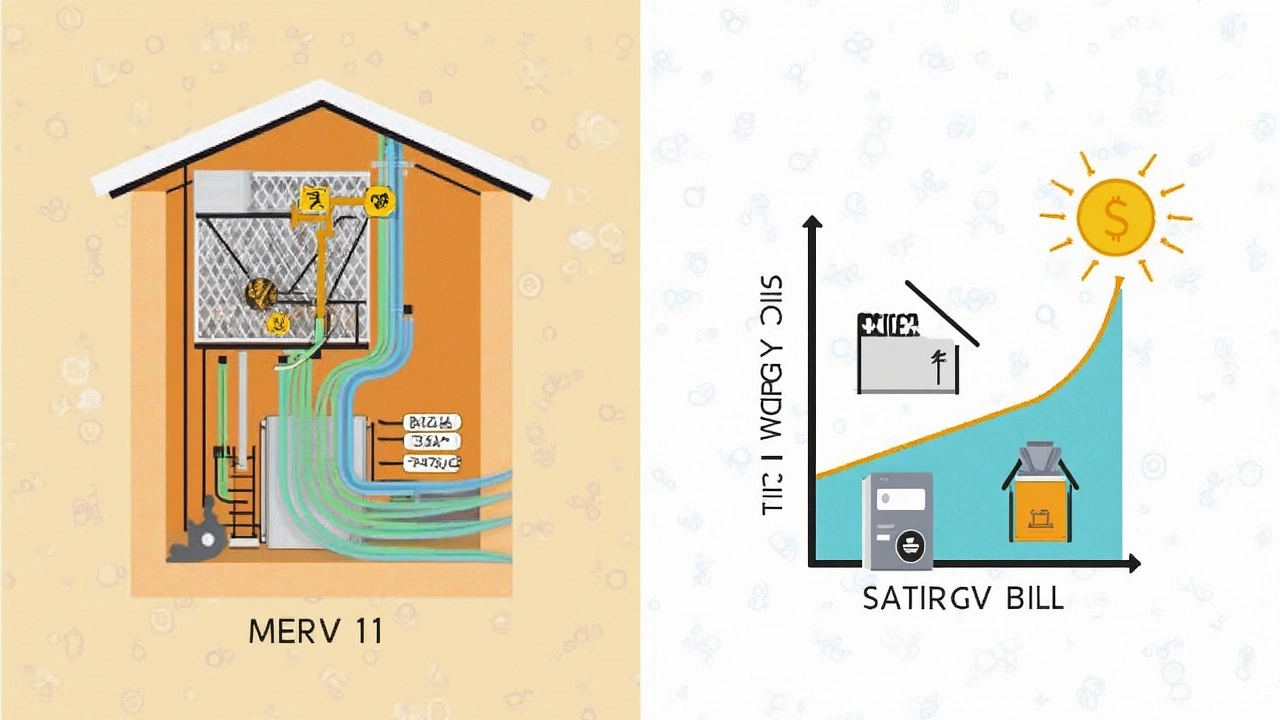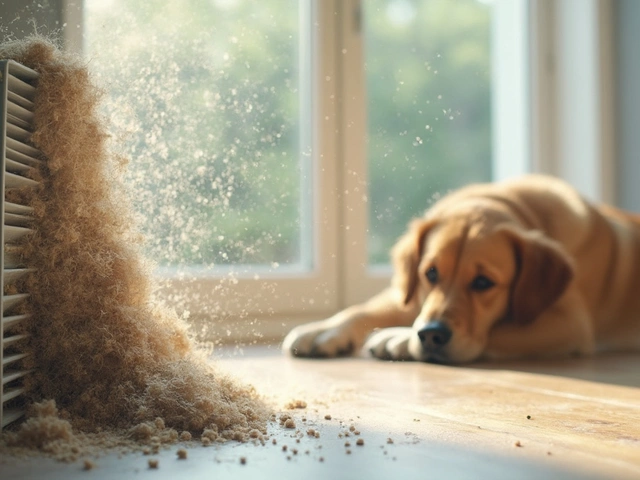When you search for air filters, it’s easy to get confused by numbers like MERV 8, 11, or 13. MERV stands for Minimum Efficiency Reporting Value, and it’s just a scale that tells you how well a filter catches stuff—everything from dust to common allergens. MERV 11 filters are often recommended for better protection, especially if you’ve got pets or allergies. But then, you hear that higher MERV might be too much for your HVAC to handle. Is that really true?
First, let’s be clear: a MERV 11 filter snags a lot more particles than the cheaper, flat-panel options. That’s great for breathing, but homeowners often worry about airflow. If your HVAC struggles to pull air through a dense filter, it can run harder, last less, and even run up your electric bill. But not every system reacts the same—some can handle a MERV 11 just fine, especially newer setups. So before you panic, it’s smart to really understand your system and your air filtering needs.
- What MERV Ratings Actually Mean
- MERV 11 and Airflow: The Science
- Real-World Performance in Homes
- Tips for Choosing the Right Filter
What MERV Ratings Actually Mean
MERV ratings are a simple way to show how good an air filter is at catching unwanted stuff circling around your home. The rating goes from 1 to 16—higher numbers mean better filtration, but also more resistance to airflow. The whole point is to help you match a filter to your needs without guessing or wasting money.
MERV stands for Minimum Efficiency Reporting Value, and it’s a standard set by ASHRAE (American Society of Heating, Refrigerating and Air-Conditioning Engineers). If you ever wondered how these ratings work, here’s the breakdown:
- MERV 1-4: Basic dust protection. Think larger stuff like carpet fibers or pollen. Most fiberglass filters you see at big box stores land here.
- MERV 5-8: Stops smaller particles—mold spores, some pet dander, and dust mites. Good for average homes without special air quality issues.
- MERV 9-12: This range, where MERV 11 sits, traps smaller allergens like auto exhaust, lead dust, and more pet dander.
- MERV 13-16: Snags even finer stuff—bacteria, tobacco smoke, and some viruses. Now you’re into the hospital zone, and most homes don’t need this.
Curious how much each level traps? Check this out:
| MERV Rating | Particle Size Filtered (microns) | % Particles Captured |
|---|---|---|
| 1-4 | >10 | Up to 20% |
| 5-8 | 3 - 10 | Up to 70% |
| 9-12 | 1 - 3 | Up to 89% |
| 13-16 | 0.3 - 1 | Up to 95% |
Manufacturers put these ratings on the side of the filter, but not everyone sells their filters with honest MERV numbers—some just say “HEPA-like” or “high performance” without test data. If you want cleaner air, always check that MERV label before you buy.
Picking the right number is about balancing clean air and not stressing out your equipment. That’s why understanding MERV matters way more than grabbing whichever box is on sale.
MERV 11 and Airflow: The Science
This is where people get nervous—will a MERV 11 filter choke off the air and hurt your system? The short answer: it depends on your unit and the filter’s build. Higher MERV filters trap smaller stuff, but as a trade-off, they can make it tougher for air to get through, especially if the filter is dirty or not well-made.
The real concern is something called "pressure drop." That’s just the HVAC term for how much a filter slows the air down. Engineers test this. For example, the average pressure drop for a MERV 8 filter is about 0.18 inches of water column (in w.c.), while MERV 11 averages around 0.22 in w.c. That’s not a huge jump—most residential blowers can handle it if the ductwork isn’t a mess and the filter fits right.
If you're running a newer furnace or air handler, chances are it was designed to work with filters up to MERV 11. Where people get in trouble is when they toss a thick, high-MERV filter into an old or weak system. Or, when they forget to swap out a filter that’s packed with gunk—airflow tanks, the blower works overtime, and parts wear out faster.
Let’s see how pressure drop compares across common MERV ratings:
| MERV Rating | Average Pressure Drop (in w.c.) | Typical Particle Size Captured |
|---|---|---|
| 8 | 0.18 | 3-10 microns |
| 11 | 0.22 | 1-3 microns |
| 13 | 0.26 | 0.3-1 micron |
Notice the numbers stay pretty close. As long as you’re not stacking filters or skipping replacements, MERV 11 filters work smoothly in most homes. They really get you better air quality without causing major headaches for airflow. But always check the specs for your HVAC system. Some older setups or budget equipment just can’t move enough air, no matter what filter you use.
Here are some signs your filter might be too restrictive for your system:
- HVAC sounds like it’s straining or runs nonstop
- Rooms feel stuffy even with the blower on
- High electric bills without a change in weather
- You spot ice or condensation on the coil or ductwork
If you notice these, don’t just yank the filter—get a pro to look at your system. Most of the time, keeping up with filter changes and using the right size will let you enjoy MERV 11 filtration with no drama.

Real-World Performance in Homes
Let’s get real about using MERV 11 filters in a regular house. Most modern residential HVAC systems are designed to work with filters up to MERV 13, so if your unit isn’t ancient, a MERV 11 usually won’t cause problems. People with allergies or asthma often notice the air feels cleaner and there's less dust on surfaces after switching from a basic filter to MERV 11. That being said, not every house has the same results, so what happens in practice?
The big concern is airflow. But in a study done by the Home Ventilating Institute in 2022, switching from a standard MERV 8 to a MERV 11 only reduced system airflow by 4% on average. Most people didn’t notice a difference in comfort or noise. The real issues popped up when filters weren’t changed on time, leading to clogs and bigger drops in airflow. So regular filter swaps are more important than worrying about the rating.
| Filter Type | Particle Removal (%) | Avg Airflow Reduction (%) |
|---|---|---|
| MERV 8 | 70 | 2 |
| MERV 11 | 85 | 4 |
| MERV 13 | 90 | 7 |
Older systems or those running borderline blower motors might be a different story. If your HVAC is over 20 years old, or you’ve noticed weak airflow even with thin filters, you might want to double-check with a technician before bumping up the MERV number. Also, not all filters are made the same. Cheap, pleated filters labeled as MERV 11 can sometimes cause more restriction than a quality one, so check reviews and maybe test a brand before setting up for the whole year.
- Change your filter every 2-3 months, or sooner if you have pets or allergies.
- If you see your utility bill spike, or feel less air coming from vents, swap the filter or drop down to a lower MERV.
- For families with allergies or respiratory concerns, the extra protection of a MERV 11 can pay off in day-to-day comfort.
Long story short, in real homes, MERV 11 strikes a solid balance for most families who want cleaner air without a big tradeoff in system performance.
Tips for Choosing the Right Filter
The trick to picking the best filter isn’t just about grabbing the highest rating off the shelf. You’ve got to balance air quality, system health, and even your budget. Here’s how to make sure you land the right one for your place.
- MERV 11 works for lots of houses, but it’s not a fit for every HVAC system. Check your system’s manual—some older or weaker units may only recommend up to MERV 8 because of airflow limits.
- Look at your actual needs. Got allergies, pets, or someone is sensitive to pollen or dust? Jumping to a MERV 11 filter will trap way more tiny particles than a basic MERV 8.
- Measure before you buy. Double-check your filter size—putting the wrong size in can let unfiltered air slip through, making even the highest-rated filter kind of useless.
- Don’t ignore your energy bill. If you just switched filters and think your AC or heat is working harder, go check your filter’s rating. Too much restriction can mean bigger bills and lead to extra wear on your blower motor.
One more thing—replace filters on time. Even a top-notch filter like MERV 11 gets clogged after a couple of months. A dirty filter blocks airflow more than the filter rating itself. Mark your calendar or set a phone reminder so you’re not running your system with what’s basically a wall of fuzz.
If you’re still stuck, try calling an HVAC tech. They can test your system’s pressure and help you figure out the sweet spot between clean air and healthy equipment.






